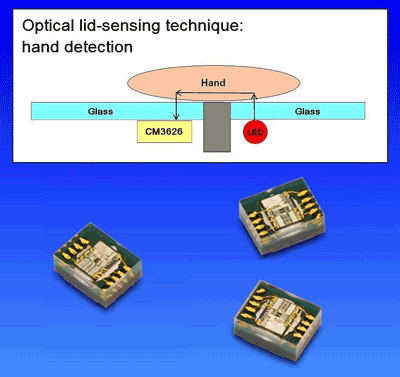Chip integrates ALS, proximity sensors with IR lid sensor
Eliminating the need for a separate magnetic lid sensor, the CM36262 integrates a patent-pending optical lid sensor with an ambient-light sensor (ALS) and proximity sensor, thus simplifying the design and reducing the cost for tablet computers, laptops, smartphones, and other consumer electronics. It is said that the optical method is more reliable, and makes it much easier to power down a tablet computer by using a fabric or leather cover, without the need to align an embedded magnet over a pickup sensor.

The optical approach allows a touchscreen to distinguish the shadow of a closed lid or fabric cover from the shadow of a user’s hand, so a device can stay powered as a hand holds the screen, or hovers over it to make selections. The approach is based on the ability of human skin to transmit an infrared light beam, whereas a lid or fabric cover is opaque; when no IR beam is detected, the chip — which works in conjunction with an adjacent IR LED that shines a beam straight out of a touchscreen glass — sends a signal over its I2 C serial interface for the touch screen to be put into power-down mode.
On the chip, the lid-sensor photodiode feeds an 8-bit ADC, which passes its digital output to a DSP running proprietary algorithms. The ALS connects to a 16-bit ADC and transfers its digital output to the same DSP. Filtron technology eliminates the need for external optical filters for both the proximity and ambient-light sensors by permitting the fabrication of an array of microscopic optical filters directly on top of the detectors. The proximity sensor diode has an IR filter while the ALS has band-pass filter that only passes green light (450 to 650 nm) to match the brightness-sensing mechanism of the human eye.
The chip includes IR diode drivers in either current or open collector mode, as well as the serial I2C bus previously mentioned. Available in an OPLGA package measuring 2.35 x 1.8 x 1 mm, the sensor operates from a 2.6 to 3.7-V supply and typically consumes 180 μA. ($0.79 ea / 1,000 — samples available now,)
Capella Microsystems , Santa Clara , CA
Sales 408-727-8500
Advertisement
Learn more about Capella Microsystems Inc.





